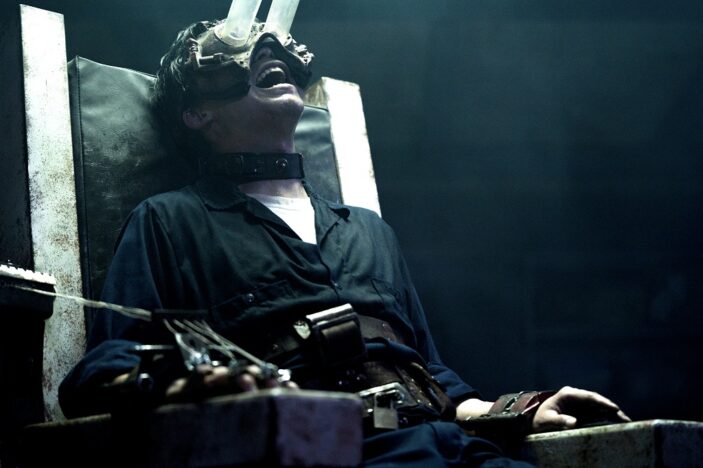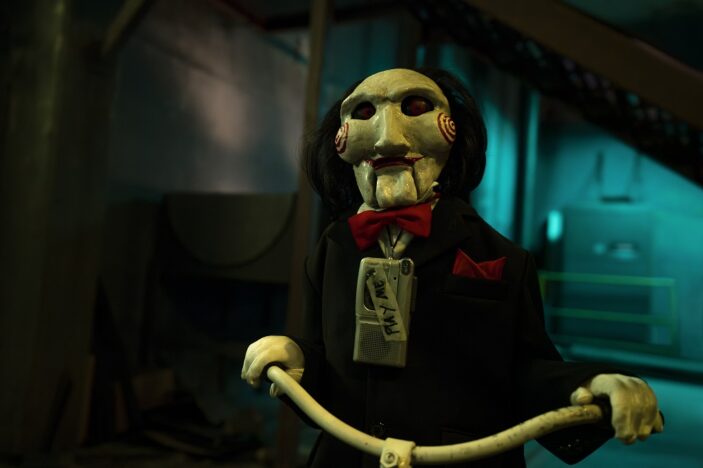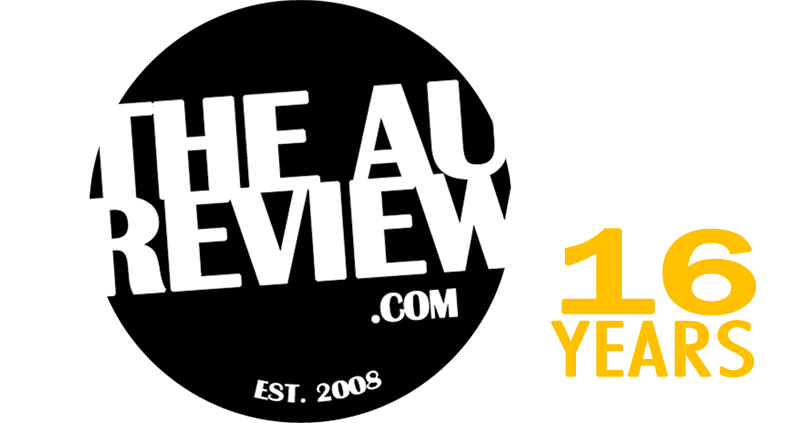
You just can’t keep a good serial killer down, can you?!?
The puppet master better known as Jigsaw has terrorised audiences – and on-screen body parts – for almost two decades now as part of the lucrative Saw film series, the little Aussie horror movie that could that birthed a billion dollar franchise.
Despite the character’s ultimate demise, Jigsaw, aka John Kramer, is returning to the cinemas just in time for the Halloween season in Saw X, a prequel-slash-sequel (emphasis on the slash) that bridges the gap between the first and second Saw films, detailing John Kramer’s journey to Mexico for an experimental medical procedure he hopes will cure his cancer. Learning the doctors involved are scam artists who prey on the sick and vulnerable, Kramer takes it upon himself to return to the killer work he knows best, turning the tables on the con artists in his signature visceral way through devious, deranged, and ingenious traps.
Ahead of the film’s release in cinemas this week, Peter Gray spoke with long-time Saw franchise collaborator, director Kevin Greutert, and production designer Anthony Stabley about pushing the limits of the franchise’s gore quota and the most important factor about returning to these films.
I feel like I’ve almost seen everything when it comes to gore in the Saw franchise, and then you go and give me “intestine rope”, so thank you for that!
Kevin Greutert: (Laughs) I think it’s a historical scene!
Without giving anything away, I was just thinking what that body goes through…It was great though, and it made me think how one of the most amazing things about this franchise are the possibilities of where you can go. Obviously, (writers) Josh Stolberg and Peter Goldfinger have experience writing within the source space, but when you’re reading the script and seeing what they’ve come up with, and I put this question to the both of you, are you ever thinking or worried that it’s gone too far?
Kevin Greutert: Yeah, I mean, we have to think about it. But we know we need to outdo the previous Saw (films) and not just escalate the scale of the sequences. Yeah, it’s the hardest part of making these films. There’s no doubt about it being fresh, but being realistic and grounded in the story itself, and not just torture.
Anthony Stabley: Yeah, I think the thing that was, as far as our goals for the traps, (it was) just connecting the medical thematics of the movie. That was important. Adding that spice of the Mexican culture, (but) also the mechanisms of being at the factory. So when you add all of those components, you have to say to yourself “Can (Jigsaw) do this?” Because if the traps are realistic and it makes sense for the audience, then they’re buying into it. And once they buy into it, then they’re terrified. It’s just pure terror! So that was really a goal. And I was constantly talking to Kevin, and we just wanted to make it real. We also wanted it to echo back to the first two (movies), so you see a lot of oxidised metal, and wheels and gears and chains, and all of that stuff. So that’s what we’re trying to do. And I feel like we achieved that.
Kevin Greutert: Yeah, in that scene in particular, of course we’re thinking about the potential for going over the top. And it was important for me for the movie to not feel campy. But I’m also game for there being some wit to this story. There are some places where, and you probably know what I’m talking about, where the audience laughs and it’s good. We want them to laugh there. I think one of the reasons why that scene works is because we had some really good actors who you laugh (with) in that scene, even though there’s absolutely nothing funny about it – except the reactions of the people involved.
I can tell you that there was a lot of yelling obscenities at the screen and laughing. I was watching it thinking that you surely aren’t going “there”, and maybe it’s sick of me but I love it! Kevin, you have a long history with this series as an editor on the first film and directing numbers 6 and 7. With 7 being hailed as “The Final Chapter” but then Jigsaw was announced, and then continued with Spiral, is it always a no-brainer for you in saying yes to being involved with these films? Or do you still need to read the script and see that it has the source spirit to be involved?
Kevin Greutert: No, it’s not a no-brainer at all. It takes a lot of consideration. There was that long hiatus after Saw 3D (The Final Chapter) before they sat me down and said, “We want you to cut this film (Jigsaw)”, and I had to think about it. I’ve done other films, of course, but I didn’t just want to do Saw, and I knew it was going to take me out of the equation, the directing equation, for a while to edit Jigsaw. But once we got into it, it was just nice to be back and, you know, part of it was just me saying to myself “I don’t want them to make a Saw without me.”
When this script came along, I was in a similar headspace where if I don’t like it, and I don’t feel like it can be made to work, then I’ll walk away. I don’t need to do it. But I loved it from the very moment I read it, and I really excitedly showed it to my wife about halfway through reading it, and she read it and we both knew what we were doing for the next year and a half.

And Anthony, when you’re starting a new project, what do you find is your most important resource? Do you mine the screenplay? Is it dialogue with Kevin? Is it independent research? Or a combination of many elements?
Anthony Stabley: Yeah, the first thing I do is I read the script to see what the tone is, and to visually gather my thoughts on it. The next part is the most important part, and that’s connecting with the director, in this case with Kevin. We both want to make sure we’re on the same page. That’s how the process starts, and then as we go together we start looking at imagery (and) making decisions based on our taste. Also, with the DP and our team, we (look at) what we like and what we don’t like, and then we make decisions on the direction that we want to take. That way we’re always making presentations (and) we’re always being open. We’re always saying, “This is what we love, and we’re going to keep going in this direction.”
Kevin Greutert: And it should be known that the cinematographer, Nick Matthews, was a huge part of that process as well. Both in the execution of it, but also in conceiving. He’s very grounded in the dark side of things. He has this love of dark art and dark cinema, and that’s what he’s all about. He’s a super friendly, nice, loving guy, but he just loved dark, like me. I think Anthony too, based on some of the things (he says), but Nick had a lot of ideas. I have always thought about Jigsaw as a kind of impresario showman who does his thing in a very theatrical way, for the benefit, of not only his subjects, but himself. I think he likes being both the director and the audience of his undertakings.
Nick not only lights the movie, but he operates the camera. There’s a lot of handheld camera in this film, and I wouldn’t necessarily say it becomes a character, but it becomes a very human element. And a good operator that holds the camera is very invaluable. We’ve used handheld camera in all of the Saw films, and I think he’s one of the best in terms of really getting in there and very organically melding with the character and reacting to what’s going on around him.
Speaking of that human element, there were some cutaway shots to Amanda regarding her thoughts on a certain character, and it added further to the odd feeling of watching this and feeling sympathetic towards Jigsaw. There’s that whole narrative that he’s never actually killed anyone, and everything he’s doing is for the right reasons, so to speak. And so much of this film looks and feels like a different sort of Saw film when it’s focusing on his journey, before it evokes that classic spirit in the latter half and we get to the nitty gritty of it all. For the both of you, are there any genre design specifics that you enjoy embracing? And on the flipside that you wanted to avoid when it came to Saw X?
Kevin Greutert: We didn’t let ourselves be intimidated by the challenge of making a film like this. For me, personally, I really put the actors through the wringer by getting so much coverage. They were good spirits about it, but, you know, Tobin (Bell) took me aside a couple of times and asked, “Do you really need all of these different camera angles?” I had the same conversation with Synnøve Macody Lund as well, the (actress) who plays Cecilia. It was this very complex scene that has a lot of the characters moving around, and we’d spent the whole day covering this person’s eyeline. We’re doing all of this stuff, and Synnøve was starting to get kind of tired. We’re sort of talking idly while somebody was setting something up, and then suddenly she jolts and says, “Oh my God, we’ve got to shoot all that fucking shit?!” (Laughs). It’s a couple of minutes of dialogue, and she’s realised we hadn’t done her angle yet. We shot her performance dozens of times for the different other camera angles, but the really key angle on her for that scene came at the end of the day, and that’s pretty hard on an actor. But she took it with grace, but I’ll never forget her saying that (laughs).
Well I can tell you one thing that isn’t fucking shit is this movie. I can’t wait to see it with a massive audience for the reactions alone. I think I just want to sit and watch other people watch the movie.
Kevin Greutert: Oh, me too! I’ve only seen it with employees at Lionsgate, and they loved it. But yeah, to see it in a regular movie theatre? I can’t wait!
Saw X is screening in Australian theatres from September 28th, 2023.
